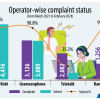Mobile subscriber numbers fell drastically in August

Following the trend of July, the number of mobile subscribers in Bangladesh dropped significantly in August.
The mobile network operators -- Grameenphone, Robi, Banglalink and Teletalk -- collectively lost about 18 lakh customers, taking the total mobile subscriber base to 19.24 crore.
In July, the operators lost a similar number of subscribers.
The overall number of mobile subscribers is calculated based on the purchase of new SIMs (subscriber identity modules) minus the number of SIMs whose ownership have become invalid for being left unused for one and a half years.
Shahed Alam, Robi's chief corporate and regulatory officer, attributed the drop to a recent SIM tax increase from Tk 200 to Tk 300. With higher SIM prices, people are less inclined to acquire additional subscriptions, he said.
"This makes it increasingly challenging to connect marginalised communities," he said, adding that higher costs have deterred many from obtaining essential access to alternative connectivity options.
Banglalink alone lost about 9 lakh customers in August, bringing its customer base to 4.24 crore. The operator lost a similar number of customers in July.
In other words, this caused the operator's subscribers base to decrease by 0.59 percent year-on-year in August.
The country's second-largest operator, Robi, lost 6 lakh customers, taking its subscriber number to 5.83 crore. Robi lost a similar number of customers in July.
However, year-on-year, the carrier saw 1.80 percent growth in customers.
The number of subscribers of Grameenphone, the leading operator, dropped to 8.50 crore from the loss of 1.6 lakh customers.
On a year-on-year basis, Grameenphone's customer base grew by 3.58 percent, the highest among the operators.
State-owned Teletalk lost about 20,000 customers, taking its total to 65.3 lakh.
Although the number of mobile subscribers in Bangladesh exceeds the population, the actual number of unique users is significantly low.
This discrepancy arises because the current regulations allow each individual to own up to 15 SIM cards, leading to a higher subscriber count than the true number of users.
According to Bangladesh Sample Vital Statistics, a project run by the state-run Bangladesh Bureau of Statistics, the percentage of individuals aged over 15 who own a mobile phone was lower in 2023 than in 2020.
This was attributed to a persistent decline in ownership since the emergence of the Covid-19 pandemic due to grim economic conditions.
In 2023, only 74.2 percent of individuals aged 15 and older owned a mobile phone, marking a slight decline from the 75.4 percent ownership rate reported in 2020.
At the peak of the pandemic in 2021, mobile phone ownership among these individuals fell by 4.1 percentage points to 71.3 percent.
It then rebounded by 2.5 percentage points in 2022. However, last year saw a modest increase of only 0.4 percentage points as the country struggled with ongoing high inflation.
A significant finding of the Bangladesh Sample Vital Statistics is the gender gap in mobile phone usage.
While 86 percent of males reported owning a mobile phone, only 62.8 percent of females did, revealing a disparity of 23.2 percentage points.
This gap highlights a serious inequality in access to mobile technology between genders, signalling the need for targeted efforts to address the underlying causes and promote equal access to mobile devices across all groups.

 For all latest news, follow The Daily Star's Google News channel.
For all latest news, follow The Daily Star's Google News channel. 








Comments